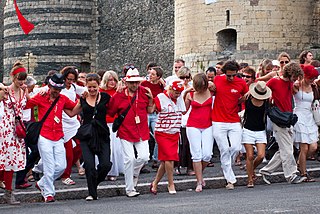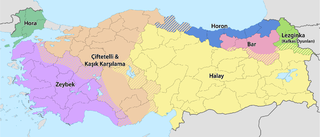 | ||||||||
| Music of Greece | ||||||||
| General topics | ||||||||
|---|---|---|---|---|---|---|---|---|
| Genres | ||||||||
| Specific forms | ||||||||
| Media and performance | ||||||||
| ||||||||
| Nationalistic and patriotic songs | ||||||||
| ||||||||
| Regional music | ||||||||
| ||||||||
Proskinitos is a form of a Greek folk dance from Macedonia, Greece. [1]
 | ||||||||
| Music of Greece | ||||||||
| General topics | ||||||||
|---|---|---|---|---|---|---|---|---|
| Genres | ||||||||
| Specific forms | ||||||||
| Media and performance | ||||||||
| ||||||||
| Nationalistic and patriotic songs | ||||||||
| ||||||||
| Regional music | ||||||||
| ||||||||
Proskinitos is a form of a Greek folk dance from Macedonia, Greece. [1]

A Greek chorus, or simply chorus, in the context of ancient Greek tragedy, comedy, satyr plays, and modern works inspired by them, is a homogeneous, non-individualised group of performers, who comment with a collective voice on the dramatic action. The chorus consisted of between 12 and 50 players, who variously danced, sang or spoke their lines in unison, and sometimes wore masks.

Sirtaki or syrtaki is a dance of Greek origin, choreographed for the 1964 film Zorba the Greek. It is a recent Greek folkdance, and a mixture of "syrtos" and the slow and fast rhythms of the hasapiko dance. The dance and the accompanying music by Mikis Theodorakis are also called Zorba's dance, the Zorba or "the dance of Zorba". The dance has become popular in Greece and one that is identified with the Greeks.

Circle dance, or chain dance, is a style of social dance done in a circle, semicircle or a curved line to musical accompaniment, such as rhythm instruments and singing, and is a type of dance where anyone can join in without the need of partners. Unlike line dancing, circle dancers are in physical contact with each other; the connection is made by hand-to-hand, finger-to-finger or hands-on-shoulders, where they follow the leader around the dance floor. Ranging from gentle to energetic, the dance can be an uplifting group experience or part of a meditation.

The hasapiko is a Greek folk dance from Constantinople. The dance originated in the Middle Ages as a battle mime with swords performed by the Greek butchers' guild, which adopted it from the military of the Byzantine era. In Constantinople during the Byzantine times, it was called in Greek μακελλάρικος χορός. Some Greeks, however, reserve the latter term only for the fast version of the dance.
Antikristos or Antikrystós is a dance of Greek origin. “Aντικρυστός” in Greek language refers to the verb αντικρύζω “be across, opposite, face-to-face”. It is also known in Armenia. Antikristos has similarities with the karsilamas dance. It is danced in couples.
Zeibekiko is a Greek folk dance.

Kochari is a folk dance originating in the Armenian Highlands. It is performed today by Armenians, Assyrians, Azerbaijanis and Turks, Kurds, and Pontic Greeks. It is a form of circle dance.
Ikariotikos or Kariotikos is a traditional dance and accompanying song originating in Ikaria a Greek island in the North Eastern Aegean Sea. Some specialists say that the traditional Ikariotikos was slow and the quick "version" of it, is a Ballos. The name Kariotikos is mostly used by the locals of Ikaria.

Karsilamas is a Turkish folk dance spread all over Northwest Turkey and carried to Greece by Anatolian Greek immigrants. The term "karşılama" means "encounter, welcoming, greeting" in Turkish. The dance is popular on Northwestern areas of Turkey, especially on wedding parties and festivals.
Sousta is a Greek folk dance, performed at weddings as an activity of courtship between husband and wife. It originates from Ancient Greece, and holds prominence in Dodecanese Islands, and broader Aegean region. It is the second most common Greek dance, after the Syrtos, with many Greek islands and villages adopting their own version. The performance of the dance reflects various gender roles, inter-played with values of romance and marriage. The Sousta acted as a socialisation process between the youth of a village, evolving into a dance central to these youth as they grew up and formed relationships with others. Socially, the Sousta also functioned as a visible verification of courtship, namely paying respects to the wife and her family. The Sousta is most commonly performed as a three-step dance, with a 'hopping' motion and crossed-over hands.
The Tsamikos or Kleftikos is a popular traditional folk dance of Greece, done to music of 3/4 meter.
Greek traditional music includes a variety of Greek styles played by ethnic Greeks in Greece, Cyprus, Australia, the United States and other parts of Europe. Apart from the common music found generally in Greece, each region of Greece contains a distinct type of folk music that originated from the region due to their history, traditions and cultural influences.

Turkish folk dances are the folk dances of Turkey. Facing three seas, straddling important trade routes, Turkey has a complex, sophisticated culture, reflected in the variety of its dances. The dominant dance forms are types of line dance. There are many different types of folk dances performed in various ways in Turkey. Zeybek, Teke Zortlatması in Aegean region, Bar in Erzurum province, Halay in the central, southern, eastern, and southeastern parts of the country, Hora in Thrace, Horon in the eastern Black Sea region, Spoon dances in and around Konya, and Lezginka in Kars and Ardahan are some of the best known examples of these.

Horon directly derives from the greek word χορός ,meaning dance,, or choron, khoron or horon, is a traditional hellenic folk dance from the Black Sea Region / Pontos of modern-day Turkey.
Greek dance (horos) is a very old tradition, being referred to by authors such as Plato, Aristotle, Plutarch and Lucian. There are different styles and interpretations from all of the islands and surrounding mainland areas. Each region formed its own choreography and style to fit in with their own ways. For example, island dances have more of a different smooth flow to them, while Pontic dancing closer to the Black Sea, is very sharp. There are over 10,000 traditional dances that come from all regions of Greece. There are also pan-Hellenic dances, which have been adopted throughout the Greek world. These include specifically the Syrtos, Kalamatianos, Pyrrhichios, Ballos and hasapiko.

The Kalamatianós is one of the best known dances of Greece. It is a popular Greek folkdance throughout Greece, Cyprus and internationally and is often performed at many social gatherings worldwide. As is the case with most Greek folk dances, it is danced in chain with a counterclockwise rotation, the dancers holding hands.
Syrtos is – in classical and modern Greece – a traditional dance in which the dancers link hands to form a chain or circle, headed by a leader who intermittently breaks away to perform improvised steps.
The Tsifteteli, is a rhythm and dance of Anatolia and the Balkans. In Turkish the word means "double stringed", taken from the violin playing style that is practiced in this kind of music. There are suggestions that the dance existed in ancient Greece, known as the Aristophanic dance Cordax, even though such a thesis is not fully evident. Furthermore, it is historically never spotted in Greece before the Greek-Turkish population exchange of 1923, and no dance in native Greek tradition shows similarities with the specific dance. Nowadays it is to be found not only in Greece and Turkey, but also in the whole of the Southeastern Mediterranean region..
Pidikhtos, is a Greek folk dance with Cretan origin, dancing in a circle formation. It is very widespread in Crete and the Greek islands.